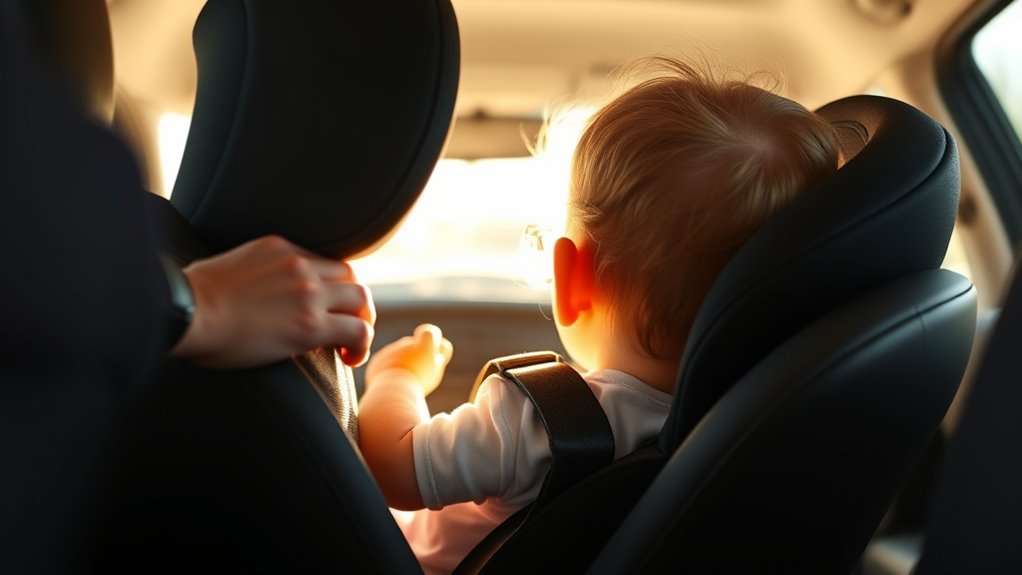Many parents make mistakes like not securing the seat tightly, using the wrong installation method, or positioning the harness incorrectly. Moving children to forward-facing seats too soon or not checking belt placement can also compromise safety. To protect your child, always verify that the seat is snug, follow manufacturer instructions carefully, and keep all straps properly adjusted. If you want to learn more tips to ensure your child’s safety, keep exploring what’s best for your little one’s car seat needs.
Key Takeaways
- Ensure booster seats are tightly installed and belts are correctly positioned across the hips and chest each trip.
- Secure rear-facing seats with proper angle and minimal movement, following manufacturer instructions carefully.
- Regularly check harness tightness and seat stability as your child grows or seats settle.
- Avoid moving children forward to booster seats too early; follow age and weight guidelines.
- Double-check all safety features and installation methods to prevent common errors and enhance protection.

Many parents unknowingly make mistakes when it comes to installing and using car seats, which can put their children at risk during travel. One common error involves improper booster seat safety. You might assume that once your child outgrows the forward-facing seat, switching to a booster seat is straightforward. However, if the booster isn’t properly secured or if your child isn’t sitting correctly, the seat won’t offer the protection it’s meant to provide. Always verify the booster seat is tightly installed according to the manufacturer’s instructions. The lap belt should lie snugly across your child’s hips, not their stomach, and the shoulder belt should rest flat across their chest and shoulder. Regularly check that the booster is secure and that your child’s harness or seat belt positioning is correct every time you travel.
Another critical mistake parents make involves rear facing installation, especially with infants and toddlers. Many assume they can switch to a forward-facing seat too early, but keeping your child rear-facing as long as possible is essential for their safety. When you install the car seat rear facing, make sure it is tightly secured, with minimal movement side to side or front to back. Use the vehicle’s seat belt or LATCH system, depending on what’s recommended for your specific seat, and double-check the angle indicator to ensure your child’s head doesn’t flop forward. Proper rear facing installation provides better support for your child’s head, neck, and spine in the event of a crash, substantially reducing injury risk. Many parents overlook the importance of this positioning, often shifting their children forward too soon, which could compromise safety.
It’s also common for parents to overlook the importance of a snug fit when installing a car seat, whether rear facing or forward facing. You should be able to press into the seat with your hand and feel minimal movement. If it shifts more than an inch in any direction, it’s not installed correctly. Many parents skip the step of tightening the straps sufficiently or fail to use the locking clip if needed. Regularly inspecting your installation ensures your child remains protected as they grow and as your vehicle’s seats settle over time.
Frequently Asked Questions
How Do I Know When My Child Is Ready to Switch Car Seats?
You’ll know your child is ready to switch car seats when they outgrow their current one in height, usually when their shoulders are above the top harness slot. Also, check if the seat belt fits properly—flat across the hips and chest, not the neck or stomach. Once these fit guidelines are met, it’s time to upgrade to the next seat to guarantee your child’s safety and comfort.
What Are the Signs of a Poorly Installed Car Seat?
Imagine your child’s safety as a delicate bridge, and a poorly installed seat is a shaky plank. You’ll notice slack in the harness tension, or the seat belt might seem loose or crooked. If the car seat wobbles or shifts when you shake it, it’s a sign it’s not secured properly. Check that the harness is snug and the seat belt is tight, ensuring your child’s ride is safe and steady.
How Often Should I Replace or Upgrade My Child’s Car Seat?
You should replace or upgrade your child’s car seat based on the car seat lifespan and replacement guidelines. Typically, it’s recommended every six to ten years, depending on the model and manufacturer. Check for any visible damage, recalls, or if your child has outgrown the seat. Upgrading ensures your child’s safety with the latest features and standards. Regularly reviewing these guidelines helps keep your little one protected on every ride.
Are There Specific Car Seat Models That Are Safest?
When choosing the safest car seat, look for models with high-quality car seat materials that meet safety standards. You should also consider brand reputation, as trusted brands often prioritize safety innovations and rigorous testing. While no single model is perfect, selecting well-reviewed seats from reputable brands guarantees better protection. Always check for the latest safety features and certifications, so your child stays secure during every ride.
Can I Use Secondhand Car Seats Safely?
Using a secondhand car seat is like playing with fire—seriously risky if not done right. You need to check secondhand safety thoroughly and follow reused seats guidelines carefully. Always verify the seat’s age, ensure it hasn’t been in a crash, and look for any damage. If you’re unsure, it’s safer to buy new. Your child’s safety depends on proper installation and seat history.
Conclusion
By avoiding these common car seat mistakes, you’re paving a smoother road for your child’s safety. Think of it as tending a delicate garden—you need to nurture and adjust to keep it thriving. Stay vigilant, double-check every buckle, and keep learning. When you do, you’ll create a secure journey for your little one, turning every trip into a safe adventure. Remember, a little attention now can steer you clear of future worries.










